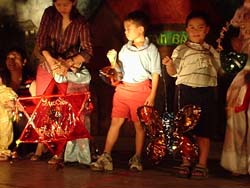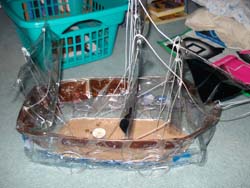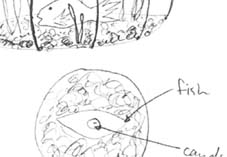The Moon Festival and Other Vietnamese Traditions in Baton Rouge, Louisiana
By Cecilia Vo
Both of my parents are from Vietnam and arrived in the United States after South Vietnam lost the civil war to North Vietnam. My father was sponsored to immigrate to the United States, but the rest of his family did not want to leave Vietnam and they still live there today. Six years after the war, my mother was able to flee Vietnam. At that time, Vietnam's Communist government did not allow residents to move away, so the only way to escape the country was by boat. Like my father, she was able to find a sponsor and come to the U.S. My mother's side of the family was lucky, and they were all able to come to America.1
The middle child of five children, I was born in New Orleans. When I was three years old, my family moved to Baton Rouge. Our Vietnamese community in Baton Rouge is small compared to places like New Orleans and Houston, but we are members of a local Catholic church, St. Anthony, which has a largely Vietnamese congregation. In our family, we still practice many of our Vietnamese traditions, and we still speak Vietnamese daily. My sisters and I were fluent in the language when we were younger, but now we speak a mixture of Vietnamese and English with our family. My brother grew up speaking English, so he understands Vietnamese but can only speak a little of the language. Our grandparents do not understand English, so we do our best to speak Vietnamese with them. We also maintain customs of showing respect and being polite to others. For example, when you visit someone else's home, or when someone visits yours, you greet everyone in order from the oldest to the youngest. When you leave, you say goodbye to everyone in the same order.
In this essay, I first briefly describe some of the Vietnamese customs my family still observes in Baton Rouge, such as foodways and customs associated with engagements, funerals, the New Year, and the anniversary of South Vietnam's fall. A lengthier discussion of the Vietnamese annual Moon Festival, as it is celebrated by my Catholic church, follows.
Foodways
My family eats mainly Vietnamese food, although every once in a while my mother may cook something else. Like others in south Louisiana, we like gumbo and crawfish. One of our Vietnamese food traditions is pho, a noodle soup often served at informal gatherings of family and friends. Most people tend to eat pho on the weekends, when they have time to get together and catch up over a bowl of soup. Some people may make it at home, while others may go out to a Vietnamese restaurant. There are two main types of pho, chicken and beef. There are also subtypes of beef pho, depending on whether you want your beef cooked, raw, or both. The cooked beef comes from the cow's shanks and briskets. When my mother cooks beef pho at home, she adds ox tails and cooks them until they are very soft, nearly falling off the bone. The ox tail is my family's favorite part of beef pho. Raw beef pho uses very lean meat from the loins and rump roasts, which cooks once it is put into a hot bowl of pho. The beef is served raw so that it will still be soft after it cooks in the pho. Both kinds of pho use the same kind of rice noodles, and the same sauces and herbs may be added to your bowl. Three different sauces are usually offered with pho: fish sauce, hoisin sauce, and chili paste. The fish sauce is usually added to increase the saltiness; the hoisin sauce, a must, is added for sweetness and flavor; and the chili paste is for those who like their pho spicy. You can also add lime or lemon, bean sprouts, chopped green onions and sliced onions, and different types of herbs such as basil and cilantro to your pho. The only difference between chicken and beef pho is the meat and the seasonings added to the broth. Chicken pho, though, takes much less time and is easier to make than beef pho.
Every Saturday, my mother makes chicken pho for lunch. She starts at eight o'clock in the morning, preparing the chicken and making the chicken broth. My father then goes to a small Vietnamese store called Hong Kong Market to buy the noodles and a bag of bean sprouts. Pho is one of the few meals we have together as a whole family. My dad works the night shift at his job, and my older sister lives in Denham Springs, while we live in Baton Rouge. Saturday is the only day of the week that we are all together to share lunch and catch up. For my family, pho symbolizes family time.
Even the time spent preparing the meal is considered family time. We all take a part in getting everything ready, and then we all grab a bowl and get as much noodles, meat, and chicken broth as we want, before sitting down at the table. We add hoisin sauce, onions, lime, bean sprouts, and herbs, and start eating. When we finish eating, we talk about what happened throughout the week, and what we are planning to do later that day or in the upcoming week. We all have our own busy schedules, and Saturday lunch with the whole family is something we all look forward to as an opportunity to slow down, relax, talk, and have a great time.
Another popular Vietnamese dish is sweet rice. There are different types of sweet rice but my favorite is a simple one: you cook the rice with some coconut milk, and add red or green food coloring. You can also put in dried strips of coconut. Red sweet rice is usually prepared for special occasions such as the Vietnamese New Year or weddings, but it can also be eaten at other times. Sweet rice is usually served with pork prepared in a certain way, although my family just buys it from a Vietnamese store.
Weddings and Funerals
In addition to making and eating Vietnamese foods, my family practices traditions associated with special events such as weddings, funerals, the Vietnamese New Year, and the anniversary of South Vietnam's loss to North Vietnam. Wedding engagement customs include the groom bringing gifts to the bride's family, and family members wearing traditional Vietnamese clothing during the engagement party. We never wear purple at a wedding because it is considered a sad color, like black, and it might bring bad luck.
For a funeral, the family of the lost loved one wears traditional Vietnamese clothing that is only worn after a death. The details of the clothing reveal exactly how the mourner is related to the person who passed away, as do different colors of fabric bands worn around the head.
Each year, my parents and grandmother observe the anniversary of South Vietnam's loss of the civil war by attending a mass at our Vietnamese church. There, people remember and pray for all the soldiers and other people who died.
The Moon Festival
My family also takes part in the Moon Festival (Tet Trung Thu) celebration held each autumn at St. Anthony Catholic Church. The festival, held in honor of the brightest full moon of the year, falls on the 15th day of the eighth month of the lunar calendar, usually in September or early October.2 The festival customarily includes special foods such as moon cakes and candy, dance performances, a lantern parade and contest, a play based on the Vietnamese legend called Chu Cuoi va Chi Hang Nga (also known as Su Tich Cay Da), and a dragon dance. In particular, I have always loved seeing the lanterns, and some years I have made lanterns with my father or sister. During the Moon Festival, candy is handed out to the children and moon cakes are sold. The moon cakes symbolize the earth and the bright full moon. There are many different types of moon cakes, but the two main kinds are a white moon cake shaped as a circle to represent the full moon, and a square cake (representing the earth) with an egg yolk (the moon) inside. We use a square shape for the earth because people long ago believed that the earth was square. The white moon cake can be made out of different kinds of flour with no filling, while the square moon cake can be made with different fillings and is more expensive.

The Moon Festival, also known as the Lantern Festival, is widely known for its main event, a lantern parade and contest. These are usually the first or last events of the festival. People make all kinds of lanterns using bamboo for the frame, and covering it with clear color sheets of plastic. Some people prefer to buy lanterns from a store. During the lantern parade, the children walk in a line, holding their lanterns (homemade or store bought) and singing a song called Tet Trung Thu Ruoc Den Di Choi. After the parade, the lantern contest takes place, and anyone with a homemade lantern may enter. The contestants go on stage with their lanterns and the judges determine the first, second, and third place winners. The prizes are usually candy, moon cakes, or money.
Another event is a performance of the play Chu Cuoi va Chi Hang Nga, based on the legend of a man named Chu Cuoi, his wife Chi Hang Nga, and a special tree called Cay Da. The story starts out with Chu Cuoi working as a logger chopping wood. When he got tired, he took a break to rest under a tree called Cay Da. As he was resting, he saw some dwarves approaching, carrying a dead body, so he ran and hid. The dwarves took some leaves from the Cay Da, crushed them, and fed them to the dead body. Chu Cuoi then saw the dead person come back to life. Learning that the tree's leaves had magical powers, he waited until the dwarves left and took some of the leaves. As he was walking home, he saw a dead dog on the road and decided to test the leaves. He crushed the leaves and fed them to the dog, which suddenly sprang back to life and from then on, followed him around. Knowing that the leaves worked, Chu Cuoi used the leaves to cure sick people in the village, or to bring them back to life if they died.
One day, a wise man saw Chu Cuoi taking care of the Cay Da. He told Chu Cuoi that the Cay Da is a very special tree and that one cannot go to the restroom under it, or else something bad will happen. Chu Cuoi took very good care of the tree, and he was able to help lots of people.
In the village there lived a rich man with a beautiful daughter named Hang Nga. It is said that she was a beautiful as a goddess. Then one day she died and her father went desperately looking for help. He heard about how Chu Cuoi can bring the dead back to life and went looking for him. He finally found Chu Cuoi, and Chu Cuoi was able to revive her. Chu Cuoi saw that she was so beautiful and asked her father for her hand in marriage. Since Chu Cuoi brought Hang Nga back to life, her father accepted, and they were happily married.
Chu Cuoi told Hang Nga about the Cay Da and warned her to never go to the restroom under the Cay Da or something bad would happen. One unfortunate day, some robbers came to their house while Chu Cuoi was out working, and they killed Hang Nga. When Chu Cuoi came home, he found his wife dead and hurried to give her crushed leaves of the Cay Da, but she did not come back to life. He found out that her intestines had been ripped out, and because of that, he was unable to revive her. His dog saw that he was very depressed and offered to give up his intestines for Hang Nga. Chu Cuoi was very grateful to the dog and was able to revive his wife.
Then one day, Hang Nga had to go to the restroom really bad, and decided to go under the Cay Da despite her husband's warnings. As Chu Cuoi was coming home, he saw his wife going under the tree, and the tree began to uproot itself. He jumped onto the Cay Da as it started to float up above the ground, and Hang Nga was taken up by the tree's roots. They then both floated up towards the moon with the Cay Da. Now whenever you look up to the moon, you can see the shadow of the Cay Da with Chu Cuoi and Hang Nga sitting under the tree. After the play, there is a dragon dance. Although the dragon dance is known for the celebration of the New Year, it is also performed during the Moon Festival. Traditionally, a man called Ong Dia dances with the dragons. He is always portrayed as a fat man with a big belly and a bald head. Ong Dia always carries a fan and has a gourd tied to the side of his waist, used as a container for wine. He dances in front of the dragons, and the dragons follow him. He gets a dragon to follow him by going in front of the dragon and waving his fan in its face. I once heard that this was called "teasing the dragon." He does this to all of the dragons while he dances, leading them around. At most Moon Festival celebrations, the dragon dance starts at one place, and ends at another location, where a red bag of money is tied to a tall pole. The dragons then compete to see which dragon can jump high enough to obtain the red bag. Each dragon is usually made up of three dancers, and the money won is then split among the three members. The dragon dance is usually the last big event of the Moon Festival.
Continuity and Change in the Moon Festival in Baton Rouge
Because our Baton Rouge Vietnamese community is small compared to other places, our festival is less glamorous than some. In fact, our festival is very simple and has changed quite a bit over the years, with some traditional events being dropped. St. Anthony Catholic Church has a Vietnamese Sunday School, and its students have always performed our Moon Festival events. For example, students will volunteer to do a dance, the traditional play, or the dragon dance. In the past, all of these performances were put on by the older students, but now we have performances by almost all age groups.
At our festival, we have the dance performances first. The dances are very simple, and are usually performed by younger Sunday School students. Then we have the play, followed by the dragon dance, both done by the older students. During the dragon dance, the dragons dance around the audience, and then exit the same way they came in (unlike bigger events in which the dragon dance begins and ends in two different places). At larger Moon Festival celebrations, groups of dragon dancers compete for prizes, but our small festival does not have a dragon competition.
When I was younger, I remember the festival being very lively and festive. The place would be decorated with lights, many people would come, students made lanterns to enter the contest, and parents made lanterns for their children; at the end of the festival, bags of candy would be passed out. I remember seeing a lantern that was a ship, and I really wanted to make a ship lantern also. But over the years, some events have changed or been dropped at the St. Anthony festival. At one point, the lantern parade was eliminated. Prizes for the lantern contest shifted from money to candy. In 2011, the lantern contest was left out of the festival, which made me very disappointed. Three years ago, on the day of the 2009 festival, I decided to make a lantern and enter the contest. I made a ship lantern with black sails like the Black Pearl from the movie Pirates of the Caribbean As I was making the lantern, my dad decided that he would make a lantern also. He made a red truck for my younger brother (Figure 2). My sister saw us having fun making lanterns, so she decided to make a lantern and made a lantern of Wall-E from the movie. Then when it was time for the lantern festival, my sister and I gave our lanterns to our younger cousins to enter the lantern contest. My lantern won second place and my dad's won third. We were very happy, and the year after that, we decided to make lanterns again.
The second year, I made two lanterns, a chandelier and a fish in a fishbowl (Figure 3). My dad made a jet for my brother. That year, we were very confident of winning, because our lanterns were much more complex than the year before. During the festival, my younger cousins left early, so my sister and I entered the contest with my brother. Unfortunately, the judges disqualified my chandelier for using artificial candles. My dad had used cardboard to make the truck that won third place the year before, so he thought it was fine to use cardboard again. His jet was disqualified for using cardboard and Christmas lights. We were very disappointed; we had put a lot of effort into making those two lanterns. Ironically, my fish-in-a-fishbowl lantern won third place even though I did not put much effort into making it.
In 2011, I made two new lanterns, a swan and a moon with three stars, for my younger cousins. My father also wanted to make a lantern that year, but my mother told him not to; she did not want a bigger mess than I had already made. When we got to the Moon Festival, we saw that no-one was carrying lanterns. We realized that there was no lantern contest that year. The contest is the reason I look forward to the festival, so we decided to go home early.
The Moon Festival at my church is starting to move away from traditional customs in other ways as well. The 2011 festival seemed to be leaning more towards the American Halloween, with many of the children there dressed in their Halloween costumes. In addition, some of the stage performances focused on Halloween. Even though we still had the traditional play and dragon dance, the main event of the Moon Festival—the lantern parade and contest—was left out.
Fewer people come to the festival than in the past, and homemade lanterns are rare now. Hopefully next year we will have the lantern contest again and a more traditional Moon Festival.
Notes
1. This essay combines two short papers originally written for an undergraduate folklore course in Fall 2011. Cecilia Vo is an undergraduate student in LSU's Landscape Architecture Program.
2. Southeast Asian calendars are based on lunar cycles, so the date according to the Gregorian calendar varies from September to early October.





